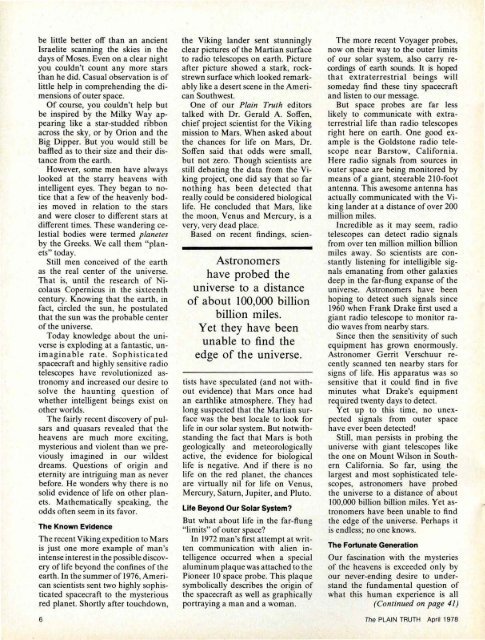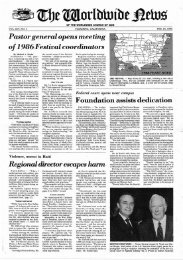Plain Truth 1978 (Prelim No 04) Apr - Herbert W. Armstrong
Plain Truth 1978 (Prelim No 04) Apr - Herbert W. Armstrong
Plain Truth 1978 (Prelim No 04) Apr - Herbert W. Armstrong
You also want an ePaper? Increase the reach of your titles
YUMPU automatically turns print PDFs into web optimized ePapers that Google loves.
e little better off than an ancient<br />
Israelite scanning the skies in the<br />
days of Moses. Even on a clear night<br />
you couldn't count any more stars<br />
than he did. Casual observation is of<br />
little help in comprehending the dimensions<br />
ofouter space .<br />
Of course, you couldn't help but<br />
be inspired by the Milky Way appearing<br />
like a star-studded ribbon<br />
across the sky, or by Orion and the<br />
Big Dipper. But you would still be<br />
baffled as to their size and their distance<br />
from the earth.<br />
However, some men have always<br />
looked at the starry heavens with<br />
intelligent eyes. They began to notice<br />
that a few of the heavenly bodies<br />
moved in relation to the stars<br />
and were closer to different stars at<br />
different times. These wandering celestial<br />
bodies were termed planetes<br />
by the Greeks. We call them "planets"<br />
today.<br />
Still men conceived of the earth<br />
as the real center of the universe.<br />
That is, until the research of Nicolaus<br />
Copernicus in the sixteenth<br />
century. Knowing that the earth, in<br />
fact, circled the sun, he postulated<br />
that the sun was the probable center<br />
of the universe.<br />
Today knowledge about the universe<br />
is exploding at a fantastic, unimaginable<br />
rate. Sophisticated<br />
spacecraft and highly sensitive radio<br />
telescopes have revolutionized astronomy<br />
and increased our desire to<br />
solve the haunting question of<br />
whether intelligent beings exist on<br />
other worlds.<br />
The fairly recent discovery of pulsars<br />
and quasars revealed that the<br />
heavens are much more exciting,<br />
mysterious and violent than we previously<br />
imagined in our wildest<br />
dreams. Questions of origin and<br />
eternity are intriguing man as never<br />
before. He wonders why there is no<br />
solid evidence of life on other planets.<br />
Mathematically speaking, the<br />
odds often seem in its favor.<br />
The Known Evidence<br />
The recent Viking expedition to Mars<br />
is just one more example of man's<br />
intense interest in the possible discovery<br />
oflife beyond the confines of the<br />
earth. In the summer of 1976,American<br />
scientists sent two highly sophisticated<br />
spacecraft to the mysterious<br />
red planet. Shortly after touchdown,<br />
6<br />
the Viking lander sent stunningly<br />
clear pictures of the Martian surface<br />
to radio telescopes on earth. Picture<br />
after picture showed a stark, rockstrewn<br />
surface which looked remarkably<br />
like a desert scene in the American<br />
Southwest.<br />
One of our <strong>Plain</strong> <strong>Truth</strong> editors<br />
talked with Dr. Gerald A. Soffen,<br />
chief project scientist for the Viking<br />
mission to Mars. When asked about<br />
the chances for life on Mars, Dr.<br />
Soffen said that odds were small,<br />
but not zero. Though scientists are<br />
still debating the data from the Viking<br />
project, one did say that so far<br />
nothing has been detected that<br />
really could be considered biological<br />
life. He concluded that Mars, like<br />
the moon, Venus and Mercury, is a<br />
very, very dead place.<br />
Based on recent findings , scien-<br />
Astronomers<br />
have probed the<br />
universe to a distance<br />
of about 100,000 billion<br />
billion miles.<br />
Yet they have been<br />
unable to find the<br />
edge of the universe.<br />
tists have speculated (and not without<br />
evidence) that Mars once had<br />
an earthlike atmosphere. They had<br />
long suspected that the Martian surface<br />
was the best locale to look for<br />
life in our solar system . But notwithstanding<br />
the fact that Mars is both<br />
geologically and meteorologically<br />
active, the evidence for biological<br />
life is negative. And if there is no<br />
life on the red planet, the chances<br />
are virtually nil for life on Venus,<br />
Mercury, Saturn, Jupiter, and Pluto.<br />
Life Beyond Our Solar System?<br />
But what about life in the far-flung<br />
"limits" ofouter space?<br />
In 1972 man's first attempt at written<br />
communication with alien intelligence<br />
occurred when a special<br />
aluminum plaque was attached to the<br />
Pioneer 10 space probe. This plaque<br />
symbolically describes the origin of<br />
the spacecraft as well as graphically<br />
portraying a man and a woman.<br />
The more recent Voyager probes,<br />
now on their way to the outer limits<br />
of our solar system, also carry recordings<br />
of earth sounds. It is hoped<br />
that extraterrestrial beings will<br />
someday find these tiny spacecraft<br />
and listen to our message.<br />
But space probes are far less<br />
likely to communicate with extraterrestrial<br />
life than radio telescopes<br />
right here on earth. One good example<br />
is the Goldstone radio telescope<br />
near Barstow, California.<br />
Here radio signals from sources in<br />
outer space are being monitored by<br />
means of a giant, steerable 21O-foot<br />
antenna. This awesome antenna has<br />
actually communicated with the Viking<br />
lander at a distance ofover 200<br />
million miles.<br />
Incredible as it may seem, radio<br />
telescopes can detect radio signals<br />
from over ten million million billion<br />
miles away. So scientists are con-<br />
.stantly listening for intelligible signals<br />
emanating from other galaxies<br />
deep in the far-flung expanse of the<br />
universe. Astronomers have been<br />
hoping to detect such signals since<br />
1960 when Frank Drake first used a<br />
giant radio telescope to monitor radio<br />
waves from nearby stars.<br />
Since then the sensitivity of such<br />
equipment has grown enormously.<br />
Astronomer Gerrit Verschuur recently<br />
scanned ten nearby stars for<br />
signs of life. His apparatus was so<br />
.sensitive that it could find in five<br />
minutes what Drake's equipment<br />
required twenty days to detect.<br />
Yet up to this time, no unexpected<br />
signals from outer space<br />
have ever been detected!<br />
Still, man persists in probing the<br />
universe with giant telescopes like<br />
the one on Mount Wilson in Southern<br />
California. So far, using the<br />
largest and most sophisticated telescopes<br />
, astronomers have probed<br />
the universe to a distance of about<br />
100,000 billion billion miles. Yet astronomers<br />
have been unable to find<br />
the edge of the universe. Perhaps it<br />
is endless; no one knows.<br />
The Fortunate Generation<br />
Our fascination with the mysteries<br />
of the heavens is exceeded only by<br />
our never-ending desire to understand<br />
the fundamental question of<br />
what this human experience is all<br />
(Continued on page 41)<br />
The PLAIN TRUTH <strong>Apr</strong>il <strong>1978</strong>

















